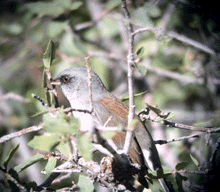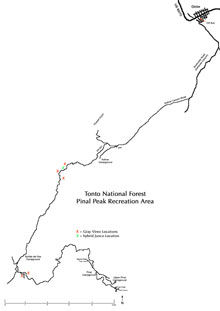 |
 |
|||||||||||||||||||||
|
||||||||||||||||||||||
Birding the Pinal Mountains
BY RICHARD C. HOYER TucsonOn an Arizona state map showing county lines, you may notice that Gila County's southern tip is a sharp wedge, penetrating into northeastern Pinal County. In the middle of this wedge is the 7,848-foot Pinal Peak, the highest chunk of land between the Salt and Gila Rivers. Although its upper slopes are draped in dense pine, fir, and aspen, it's too far north to be considered part of the typical southeastern sky islands; but the Salt River Canyon to the north also isolates it from the coniferous forests of the Mogollon Rim. This gives this mountain a unique character as central Arizona's own sky island, and it shares birds from both regions.
I first became curious about the Pinal Mountains when I read in Monson and Phillips' Annotated Checklist of the Birds of Arizona (1991) that an Orange-billed Nightingale-Thrush had been reported here mid-April 1974, a bird that was watched for over a half hour. Considering that this species has been predicted to occur in Arizona, that the isolation of the forest makes these mountains a vagrant trap, and that the species when seen well is very distinctive, I figure that it's probably a good record. I decided that these little-known mountains deserved some more birding attention.
Located in the Tonto National Forest, the region is designated as the Pinal Recreation Area. As you ascend the mountain, the first habitat is chaparral, with scattered oaks and junipers until the pine forest begins. Birds here are what one would expect for much of central Arizona: year-round it's chock full of Spotted Towhees, along with resident Hutton's Vireo, Western Scrub-Jay, and Juniper Titmouse. In the summer Black-chinned Sparrow, Black-throated Gray Warbler, and Gray Vireo can be found. In the upper elevations, one first enters pine forest and then near the peak a much cooler fir and aspen forest. More typical of northern Arizona forests are breeding Orange-crowned Warbler and Mountain Chickadee found here, and MacGillivray's Warbler may also breed. But several species typical of southeastern Arizona also occur here, including Bridled Titmouse; Zone-tailed Hawk; Olive, Red-faced, and Grace's Warblers; and this place is perhaps best known as the northernmost range of Yellow-eyed Junco.
To get to the Pinal Recreation Area, one must first get to Globe, along US 60/70 in Gila County east of Phoenix. Just west of the old downtown the highway is heading to the south-southeast (SSE) and bends sharply to east-northeast to cross over Pinal Creek; turn right (SSE) at Hill St. immediately on the east side of the bridge. If coming from the east, this will be a left turn just before crossing the bridge. At the stop sign in 0.2 mile turn right, then almost immediately left again to cross over the railroad tracks and to the south side of Pinal Creek; there should be signs directing you to the recreation area. In another 0.9 mile turn right on Sixshooter Road, just past a small bridge. In another 1.8 miles, turn right at a stop sign to head up Kellner Canyon. Once on Tonto National Forest, you can pull over at any wide spot and begin birding almost anywhere. One productive spot is the former Kellner Campground, which one must now walk to, beyond a locked gate. In 2001 there was a large grove of cottonwoods here, and on June 8, while birding with Gene Loring, Peter Salomon, and Bob Proniewych, I found a singing male Hooded Warbler. In the fall of 2004 it looked as if drought had taken a toll on these cottonwoods.
Past the turnoff to Kellner Campground the road comes to a small divide with a cattle guard and the junction with Forest Route 651. To the right is another access route from US 60/70, which I have not taken, while turning left leads to the higher elevations. One passes through an area of open chaparral (Spotted Towhee, Black-chinned Sparrow, and Crissal Thrasher) before coming to the oak-juniper belt for which Gray Vireo is known. One stretch of road that has been most productive for this species is near the coordinates 33º 19.944', W 110º50.698. It was in this area on September 30, 2004, that I found a junco that appeared to be a hybrid Yellow-eyed x Dark-eyed Junco. Its plumage was most like that of Yellow-eyed Junco but the eye was a dark brown, and the call note was somewhat intermediate. At the same place and time Mark Stevenson found a "Slate-colored" Fox Sparrow, probably a rare winter visitor as elsewhere in Arizona.
Shortly above this area one reaches the first pine forest. On July 30, 2001, I arrived with Tim Rodenkirk on a morning with heavy clouds and a giant, decaying monsoonal storm. When the rain finally halted in the late morning, our first stop at the Sulfide del Rey Campground seemed quiet at first. But almost immediately after I began pishing we were surrounded by the largest flock of warblers I have ever seen in Arizona. It contained at least 75 birds, mostly Grace's Warbler, with several Olive,
Yellow-rumped, Hermit, Townsend's, Red-faced, Nashville, and Painted Redstart among them.
Above Sulfide del Rey, one comes to a main junction and the pass; the only area I have explored is the road to the left which leads to Pinal Peak and the campgrounds. This first stretch stays on the south-facing slopes where chaparral reaches a higher elevation. I have had Gray Vireo in this area on a couple occasions. Where the road crosses back over to the north-facing slopes, the forest is again dense, and one finds the likes of Red-breasted Nuthatch and Brown Creeper, and at least in early fall this is a good area for Yellow-eyed Junco. There are many private cabins from here on up to the top. Once near the top you reach a fork, the right taking you to the peak and radio towers with a more open Gambel's oak and moist chaparral. The left fork stays on the protected forested slope and ends at the Upper Pinal Campground. On my first visit May 23, 2000, I saw a Dusky-capped Flycatcher near the peak, which seems to be rare here, and a MacGillivray's Warbler, possibly a breeding bird. It is in this area where one can find Golden-crowned Kinglet, Orange-crowned Warbler, and presumably where the Orange-billed Nightingale-Thrush was seen.
A lot remains to be discovered in the Pinal Mountains, both in terms of its regularly occurring avifauna as well as rare visitors. Northern Pygmy-Owl, though not mentioned specifically in either the Annotated Checklist or by Phillips, et. al. (1964), may occur here, and if so, it would be interesting to note which subspecies it is. Confirmation of breeding Dusky-capped Flycatchers would certainly be of interest, and one might be able to find mixed pairs of Yellow-eyed and Dark-eyed Juncos in the breeding season. Breeding confirmation of MacGillivray's Warbler would also be news. There is a fair amount of forest on the northern slopes, certainly too much to cover thoroughly, but it is still much less than on any of the other sky islands of southern Arizona. This means that any vagrants should be easier to find here than in other areas.
Literature citedMonson, G. and Phillips, A. 1991. Annotated Checklist of the Birds of Arizona. University of Arizona Press, Tucson.
Phillips, A., Marshall, J., and Monson G. 1964. The Birds of Arizona. University of Arizona Press, Tucson.

Hybrid between Dark-eyed and
Yellow-eyed Junco in Pinal Mountains
Photo by Rich Hoyer
Updated
|
©2005
|
HOME | | | REPORT SIGHTINGS | | | PHOTOS | | | BIRDING | | | JOURNAL | | | ABOUT US | | | CHECKLISTS | | | AZ BIRD COMMITTEE | | | EVENTS | | | LINKS |
